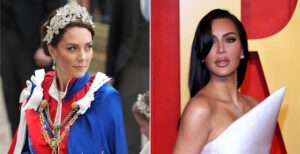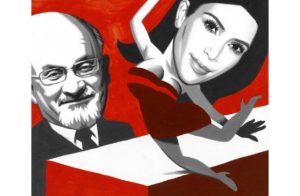The public backlash against an altered photo of the royal family shows that, even in the age of social media, royalty is supposed to mean more than just celebrity.
March 15, 2024
There I was on CBS News at the beginning of March, as a commentator on the royals, pooh-poohing fears that the public was being deceived. The Princess of Wales’s three-month absence from public life following her surgery in January was generating far too much hysteria.
Yes, it was a little strange that Prince William had suddenly withdrawn from a scheduled public appearance citing a “personal matter.” And there was no denying that the two royal households were not in sync. 
Buckingham Palace’s willingness to share photographs of the cancer-stricken King Charles III made the news blackout on Princess Catherine look suspicious. But Kensington Palace, the residence of the Waleses, had been quite clear from the outset that it wouldn’t be issuing any updates until her convalescence was over. Trust me, I had said, the real issue here is the fact we are paying too much attention to baseless rumors.
Two weeks later, where-is-Kate-gate had turned into photogate. The world had been clamoring for a picture to show that she wasn’t in a coma, on a beach filing for divorce or recovering from a Brazilian Butt Lift, as some speculated on social media. What it got on March 9, Mother’s Day in Britain, was an Adobe Photoshop special in the worst way.

The charming family portrait of Kate sitting on a bench, surrounded by her three children, was bound to be scrutinized pixel by pixel. At the very least, it needed to be devoid of any mystery. Instead, the image had been obviously but crudely digitally enhanced, giving credence to every crackpot theory out there. By being secretive and then looking manipulative, the Waleses had created a public relations catastrophe. And they had damaged their “brand,” which depends crucially on how their public role transcends that of mere celebrities.
For the record, I don’t have any inside information about Kate’s surgery. The Germans think it was diverticulitis, the British assume it was a hysterectomy. But leaving aside the knotty question of privacy, the royals’ junior varsity team needs a reset. Even if the fiasco was the result of a mislabeled file, or a key member of the comms office bunking off early on a Friday, William and Kate are playing like amateurs in a pro sport that kills its losers.
But the bigger issue exposed by photogate isn’t a “them” problem at all, it’s an “us” problem. Americans are behaving as though Kate cheated on them. The betrayal! She has done what no one else in this country has ever managed to do and unite the conservative and liberal media around a cause they are both passionate about: the evils of royal photoshopping. It’s a breach of trust, don’t you know, and Americans won’t stand for it.
Lest we forget, in 1953 the newly crowned Elizabeth II deep-faked her official coronation photograph, which remains one of the most famous images of the 20th century. It was taken after she had left Westminster Abbey and returned to Buckingham Palace. The photographer Cecil Beaton sat her in front of a painted backdrop of the Abbey’s interior so he could make it look all dreamy and romantic, gloomy gothic not being his style.
No one accused Queen Elizabeth of scamming the public. But for Kate there’s no mercy. She has been “outed” as a fake. If people discovered that Kim Kardashian, the “Queen of Reality TV,” was actually a composite character played by identical triplets, I doubt it would cause this much outrage.

A print of Queen Elizabeth II’s 1953 coronation photo, which was taken in front of a painted backdrop, not at Westminster Abbey. PHOTO: HERITAGE IMAGES/GETTY IMAGES
In fact, it isn’t far-fetched to compare the Windsors and the Kardashians as living megabrands, family enterprises whose presence on social media and ability to sway public opinion are totally out of proportion to their actual physical footprint. But however much they may resemble each other in their reach, they are opposites in terms of what they represent, and that may be why the response to Kate’s doctored photo was so visceral.
Over the years, Kim Kardashian has tried not just to emulate Kate but to be the American equivalent. Whether it was delusional or simply delusions of grandeur, the reality TV star modeled her own 2011 wedding to the NBA player Kris Humphries after William and Kate’s, even going so far as to order a similar cake at the reception. There were only four months between the two weddings so comparisons between the two were unavoidable. The press played along, sort of, variously referring to the Kardashian-Humphries $10 million extravaganza as “America’s Royal Wedding” and the “royal-ish wedding.”
Both weddings catapulted the brides into even greater stardom. But let us not forget the very different ways they have acquired and used their fame. In the age of social media and AI, the key differences between the two family brands hinge on what we now mean by “real” and “authentic” and “genuine.”
Kim Kardashian owns a global business empire, has 364.4 million followers on Instagram and still has her own reality TV show, renamed “The Kardashians.” She makes money playing a fake version of herself that people are willing to accept as “real” without caring which bits might be true and which are faked.
By contrast, Kate works for a nonprofit that pays the Waleses comparatively little and prohibits conspicuous displays of luxury. Her shared Instagram account with William has a mere 15.2 million followers. Although they, too, have a long-running TV show about their family, with their early romance concluding the most recent season, “The Crown” is too unflattering to be a vehicle for self-promotion.
Kate has no say or ownership in her show and has to watch an actor play a fake version of herself that people know isn’t real but nevertheless believe to be true on some level. She is a permanent resident inside a hall of mirrors that reflects two things: ratings and popularity.
But her job is of an older sort: Kings and queens have no career path or rank to attain. They exist in a different category from the rich, the famous and the beneficiaries of nepotism. The monarch can only be sui generis.
Over the years, the British monarchy has learned how to present itself as the embodiment of duty and public service. The royals are buoyed by the timeless values that define them. Queen Elizabeth II was authentic to a fault. The public’s grief at her passing reflects how deeply that quality still resonates.
Social media has trapped us all in a very different world, especially in the U.S., where public opinion has always been the ultimate power. It’s what caused Alexis de Tocqueville the most disquiet when he visited America in 1831. “It acts upon the will as well as upon the actions of men,” he wrote in “Democracy in America.” But when public opinion is the final arbiter of everything, where does that leave authenticity and the values it safeguards?
Fear that the royals are squandering the values and credibility of the monarchy is what provoked the internet-wide howl of rage over Kate’s photograph. I now realize why people rushed to fill the silence surrounding the Waleses with outrageous speculation. Scandal is somehow preferable to seeing Princess Catherine reduced to Kim Kardashian.








